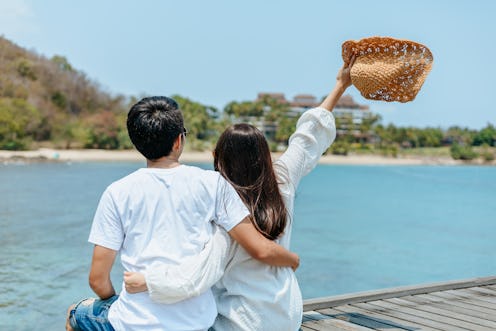Life
The Grim Reason We Go On Honeymoons

If you’re in the midst of wedding planning, no doubt you are looking forward to your honeymoon almost as much as the whole “getting married to your heart’s desire” thing. But have you ever wondered why people go on honeymoons? Or why they’re called “honeymoons” in the first place? The truth is, the history and etymology of the honeymoon isn’t totally clear — but the reasons behind these post-wedding vacays might be a bit grimmer than you’d think.
The term “honeymoon” dates back as far as the 16th century, though back then, it simply referred to the month following a wedding, not a vacation. In 1552, writer Richard Huloet defined “Hony mone” as “a term proverbially applied to such as be newly married, which will not fall out at the first, but th’one loveth the other at the beginning exceedingly, the likelihood of their exceadings love appearing to aswage, ye which time the vulgar people call the hony mone.”
Samuel Johnson, the English essayist and poet, defined “honeymoon” as “The first month after marriage, when there is nothing but tenderness and pleasure; originally having no reference to the period of a month, but comparing mutual affection of newly-married persons to the changing moon which is no sooner full that it begins to wane….” Thus for both Huloet and Johnson, the honeymoon is the period at the beginning of the marriage when everyone is happy and in love — but they both warn that, in short order, the couple’s ardor will cool, and the honeymoon phase will be over.
“Honeymoon” didn’t start referring specifically to travel following a wedding until the late 18th century. In Britain, couples would take a “bridal tour” to visit friends and family who couldn’t make it to the wedding. George P. Monger writes in Marriage Customs of the World that it was common for aristocratic or wealthy British couples in the early 19th century to visit Europe on their honeymoons, but middle class newlyweds would travel to places less far afield, like the local seaside. Americans caught onto the tradition toward the end of the 19th century. Tourism and leisure travel boomed in this period, so it’s no wonder that honeymoons became more and more associated with traveling. By the 1940s and 50s, the honeymoon had become an established tradition practiced by people of all classes.
Cosmopolitan points out that more and more people are now waiting until quite a while after their weddings to take their honeymoons, often in order to save up money for the trip or to be able to take more time off work. This trend has created a new term: “Mini-moon.” The mini-moon is a short trip that some couples take immediately following their weddings, which are then followed by more elaborate honeymoons down the line.
Images: Chay Chay Sae Hêng / EyeEm/EyeEm/Getty Images; Giphy